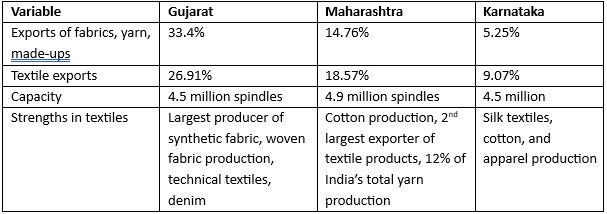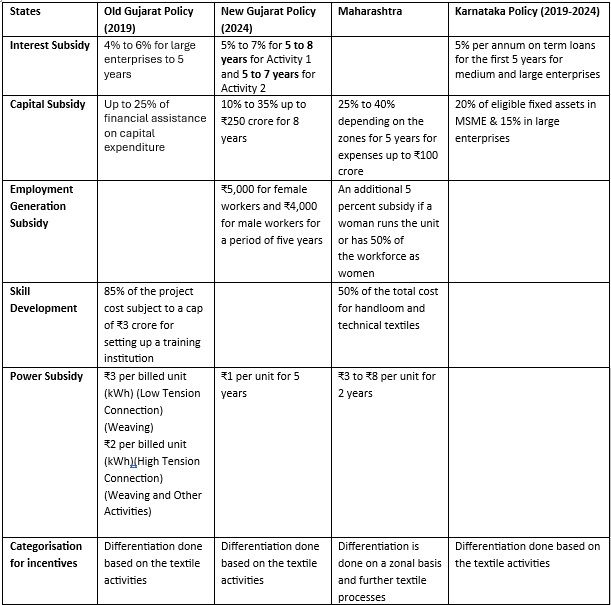
The Gujarat government has finally come up with a new textile policy to revive the sentiment for companies to set up textile units in the state and further bolster employment and investments in the sector. The new policy has introduced capital subsidies and increased the ceiling for the employment generation subsidy, which will have positive effects for the state in the long term.
A comparison of the new policy with the existing policies in states like Maharashtra and Karnataka will give a better picture. However, prior to comparison, it is important to recognise the unique strengths of Gujarat, Maharashtra, and Karnataka within India’s textile industry.
Gujarat and Maharashtra are the leading cotton-producing states, with significant spinning capacities that meet much of the domestic demand. Gujarat is particularly notable for its advanced, machine-operated businesses and is a powerhouse in manufacturing and exporting technical textiles, contributing around 25 per cent of India’s output in this sector.
The Maharashtra government’s MAHA TUFS programme provides substantial incentives to textile players, but the state struggles to match Gujarat’s dominance in technical textiles.
Karnataka plays a crucial role, especially in silk production, being the largest producer of mulberry silk in India, contributing nearly 65 per cent of the total output. The state has also made strides in cotton textiles and ready-made garments (RMG), particularly in Bengaluru. However, Karnataka lags behind Gujarat and Maharashtra in scale and investment in technical textiles.
The Karnataka Textile Policy focuses on promoting MSMEs through capital subsidies and fixed asset investment incentives. Despite these efforts, it faces tough competition from Maharashtra, which offers more aggressive policies to attract large-scale investments. While Karnataka benefits from a skilled workforce and a robust RMG sector, it requires stronger policy support to enhance processing capacities and attract investment in high-value segments.
Comparative Analysis of Textile Industry Performance: Gujarat, Maharashtra, and Karnataka
Gujarat, Maharashtra, and Karnataka hold prominent positions in India’s textile industry, each with unique strengths and contributions to exports and employment.
Table 1: Textile Industry Statistics: Maharashtra, Gujarat and Karnataka, 2023

Source: MIDC, Government of Gujarat, AEPC, Karnataka department of Handlooms and textiles
Gujarat leads India in synthetic and woven fabric production, serving as a major hub for technical textiles and denim. The state contributes 33.4 per cent to India’s exports of fabrics, yarn, and made-ups, and accounts for 26.91 per cent of total textile exports. With a spindle capacity of 4.5 million, Gujarat remains a formidable player in the textile sector. Employment generation is another key strength, with approximately 6 crore individuals engaged in the industry.
Maharashtra contributes 14.76 per cent to India’s exports of fabrics, yarn, and made-ups, and makes up 18.57 per cent of the country’s total textile exports. It is a critical player in cotton production and ranks as the second-largest exporter of textile products in India. With a spindle capacity of 4.9 million, Maharashtra supports significant yarn production, which constitutes 12 per cent of India’s total output. The textile sector also plays a vital role in employment in Maharashtra, contributing to 10.2 per cent of the state’s total workforce.
Karnataka, renowned for its silk and cotton textiles, holds a smaller yet significant share in textile exports, contributing 5.25 per cent to India’s exports of fabrics, yarn, and made-ups and 9.07 per cent of total textile exports. The state has a spindle capacity of 4.5 million and continues to be an important player in apparel production.
Together, these states are pivotal in shaping India’s textile industry and enhancing its global competitiveness. Successive governments have propelled the sector through various policies, ensuring steady growth. However, to further enhance capabilities and foster sustainable expansion, it is crucial to create a favourable environment that attracts investments from both domestic and international markets.
Key areas where government support is crucial include offering interest subsidies, capital subsidies, and power subsidies, which can alleviate operational costs and stimulate growth. Additionally, fostering innovation and modernisation within the industry is vital. This requires targeted policies that promote the adoption of cutting-edge technologies and sustainable practices, ultimately strengthening the industry’s global standing and ensuring long-term growth.
Gujarat Revitalising the 2019 Policy: Key Enhancements in the 2024 Textile Strategy
A comparison between Gujarat’s Old Textile Policy (2019) and New Textile Policy (2024) highlights a strategic shift towards more robust incentives, reflecting the state’s ambition to further strengthen its textile industry and attract higher levels of investment.
Table 2: Policy Comparison: Gujarat, Maharashtra, and Karnataka in the Textile Sector

Source: Reports of textile policies of Gujarat (2019) (2024), Maharashtra (2023-2028) and Karnataka (2019-2024)
The New Textile Policy aims to address these concerns by carefully evaluating the list of goods subject to QCOs before any further extensions. This strategic approach seeks to balance the need for quality control with the necessity of supporting local textile production, ensuring that Gujarat can continue to thrive in the competitive textile market.
Eligible Fixed Capital Investment: In the New Textile Policy, the Gujarat government emphasises the need to focus on each sub-sector, which is essential given the introduction and enforcement of the QCOs. The document also discusses a capital subsidy on Eligible Fixed Capital Investment (eFCI) to attract more investors into the Gujarat textile industry. The significance of resources such as land, warehouses, and equipment have greatly impacted the textile sector. Complaints about higher rents for existing warehouses due to a lack of storage facilities have been a cause of concern for the entire value chain. Repeated wartime situations, especially in key trade routes, have significantly affected container and freight rates. A capital subsidy on eFCI would be particularly beneficial for the construction of warehouses for textile exporters.
Inclusion of spinning units: A major takeaway for the Gujarat textile industry is the inclusion of spinning units for yarn produced from fibres. There is also a renewed interest in polyester and viscose, which have gained prominence in the current textile landscape. In addition to the demand for polyester and viscose, fabric manufacturers have been shifting towards polyester and viscose fabric production using imported fibres for final production. This shift has occurred due to the persistently high cotton prices in the calendar year 2023, which significantly hurt cotton fabric manufacturers. The current Gujarat textile policy has successfully captured the needs of both exporters and consumers.
Subsidy on investment in machinery: The industry would also benefit from the capital subsidy through investments in machinery and advanced equipment. Industry leaders have repeatedly expressed their displeasure at the closure of the TUFS schemes since 2022, and the increase in subsidy rates from 10 per cent to 35 per cent is a welcome change for investment in machinery.
Overall, the New Gujarat Textile Policy (2024) represents a comprehensive improvement, focusing on longer-term financial support, higher capital subsidies, employment incentives, more strategic energy cost management, quality management etc. This creates a more attractive environment for both domestic and international investors, fostering sustained growth, innovation, and competitiveness in Gujarat’s textile industry.
Comparison of Gujarat, Maharashtra, and Karnataka Textile Policies
The Gujarat (2024), Maharashtra, and Karnataka (2019-2024) textile policies reveal a variety of approaches to enhancing their textile industries. Here’s a comparison of key policy aspects across these states:
1. Interest Subsidy:
2. Capital Subsidy:
3. Employment Generation Subsidy:
4. Skill Development & Sectoral Support:
5. Power Subsidy:
6. Differentiation for Incentives:
A Synoptic View
Overall, Gujarat’s 2024 Textile Policy stands out for its holistic approach, offering long-term subsidies tailored to specific textile activities. This focus makes it highly attractive for large-scale investments and sector-specific growth, positioning the state as a leader in textile innovation and expansion.
Maharashtra’s policy, on the other hand, is regionally focused, offering competitive short-term subsidies based on geographical zones and workforce composition. This approach encourages localised development but lacks the long-term vision of Gujarat’s policy.
Karnataka’s policy is more conservative, primarily supporting small and medium-sized enterprises (MSMEs) through fixed asset incentives. While it provides limited large-scale benefits, it ensures stable support for smaller players. Overall, Gujarat’s policy is forward-looking, while Maharashtra targets regional development, and Karnataka offers steady support to MSMEs.
Revamping Key Policy Areas: The Path Forward
One of the critical challenges facing India’s textile industry is the lack of state-of-the-art processing capabilities. Despite various policy initiatives introduced by both Central and state governments, the processing sector remains a weak link in the textile value chain. There is a noticeable absence of demonstrative policy declarations, and existing policies inadequately address the pressing needs of this sector. Strengthening processing capabilities is essential for enhancing India’s global competitiveness and ensuring sustainable growth in the textile industry.
Although the state is one of the largest producers of cotton, its processing capabilities are insufficient, resulting in the need to transport cotton to Maharashtra and Tamil Nadu for further processing. While the state has the potential to produce technical textiles, fabrics, and yarn, the lack of supportive government policies for the processing of cotton has hindered the textile industry from expanding its existing capacities.
To retain and enhance its competitive edge, the state must implement effective policies that strengthen its processing sector, ensuring it can fully leverage its cotton production and fulfil the growing demand for value-added textile products.
The textile industry has encountered significant bottlenecks related to power tariffs, support for transitioning to alternative energy sources, and sustainability. In Gujarat, the power tariffs are notably higher, with no accompanying power subsidies, especially when compared to Maharashtra and Tamil Nadu, where generous power subsidies are provided. In Maharashtra, for instance, the government mandates that companies install solar units and offer support for their construction, promoting renewable energy adoption.
However, both the new and existing textile policies in Gujarat offer minimal support for solar and renewable energy initiatives. This lack of assistance, coupled with the higher cost of land and elevated power tariffs, has led many local manufacturers to relocate to the MIDC area of Navapur, Maharashtra where they benefit from cheaper land and more substantial power subsidies. As a result, Gujarat’s textile sector faces challenges in retaining manufacturers and fostering a sustainable energy landscape.
Dr. Paramananda Nayak
Receive daily prices and market insights straight to your inbox. Subscribe to AlchemPro Weekly!